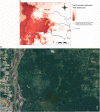Mapping Potential Population-Level Pesticide Exposures in Ecuador Using a Modular and Scalable Geospatial Strategy
- PMID: 37426690
- PMCID: PMC10326482
- DOI: 10.1029/2022GH000775
Mapping Potential Population-Level Pesticide Exposures in Ecuador Using a Modular and Scalable Geospatial Strategy
Abstract
Human populations and ecosystems are extensively exposed to pesticides. Most nations lack the capacity to control pesticide contamination and have limited availability of pesticide use information. Ecuador is a country with intense pesticide use with high exposure risks to humans and the environment, although relative or combined risks are not well understood. Here, we analyzed the distribution of application rates in Ecuador and identified regions of concern because of high potential exposure. We used a geospatial analysis to identify grid cells (∼8 km × 8 km) where the highest pesticide application rates and density of human populations overlap. Furthermore, we identified other regions of concern based on the number of amphibian species as an indicator of ecosystem integrity and the location of natural protected areas. We found that 28% of Ecuador's population dwelled in areas with high pesticide application rate. We identified an area of ∼512 km2 in the Amazon region where high application rates, large human settlements, and a high number of amphibian species overlapped. Additionally, we distinguished clusters of pesticide application rates and human populations that intersected with natural protected areas. Ecuador exemplifies how pesticides are disproportionately applied in areas with the potential to affect human health and ecosystems' integrity. Global estimates of population dwelling, pesticide application rates, and environmental factors are key in prioritizing locations to conduct further exposure assessments. The modular and scalable nature of the geospatial tools we developed can be expanded and adapted to other regions of the world where data on pesticide use are limited.
Keywords: agrochemicals; ecosystem; environmental pollution; pesticides; population health; spatial analysis.
© 2023 The Authors. GeoHealth published by Wiley Periodicals LLC on behalf of American Geophysical Union.
Conflict of interest statement
The authors declare no conflicts of interest relevant to this study.
Figures






References
-
- Andino Padilla, D. U. (2021). Intoxicaciones ocupacionales agudas por herbicidas en Ecuador durante el periodo 2016–2020. Universidad Internacional SEK. https://repositorio.uisek.edu.ec/handle/123456789/4400
-
- Anselin, L. (1995). Local indicators of spatial association—LISA. Geographical Analysis, 27(2), 93–115. 10.1111/j.1538-4632.1995.tb00338.x - DOI
-
- Bivand, R. , Keitt, T. , Rowlingson, B. , Pebesma, E. , Sumner, M. , Hijmans, R. , et al. (2015). Package ‘rgdal’. Bindings for the Geospatial Data Abstraction Library. Retrieved from https://cran.r-project.org/web/packages/rgdal/index. html
-
- Bivand, R. , Rundel, C. , Pebesma, E. , Stuetz, R. , Hufthammer, K. O. , & Bivand, M. R. (2017). Package rgeos. The Comprehensive R Archive Network. (CRAN).
LinkOut - more resources
Full Text Sources
